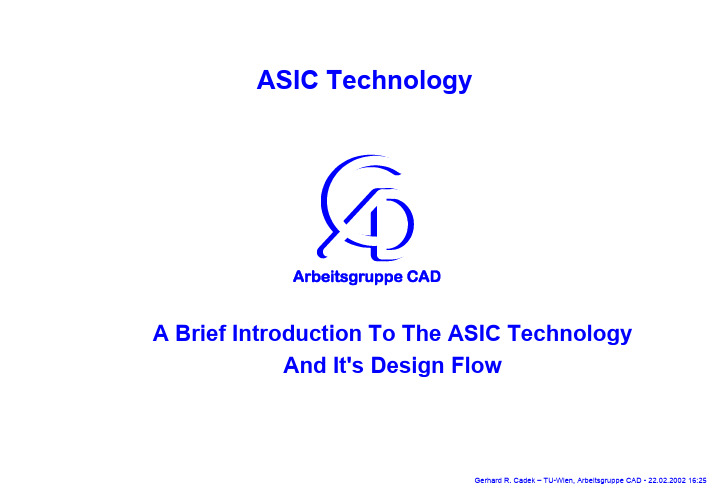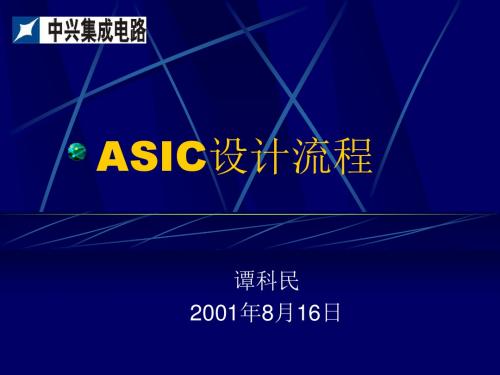第3章ASIC设计流程.pptx
ASIC设计理论与实践-第3章

第3章 中央处理器
21
操作数寻址
基址寻址方式
专门设置一个基址寄存器或者指定一个通用寄存器作 为基址寄存器。基址寻址方式是将基址寄存器的内容 加上指令中的形式地址而形成有效地址。
第3章 中央处理器
22
操作数寻址
变址寻址方式
变址寻址方式计算有效地址的方法与基址寻址类似, 但是变址寻址方式是将指令中的形式地址作为基准地 址,变址寄存器的内容作为修改量,来得到有效地址
第3章 中央处理器
29
算术逻辑单元
指令寄存器根据指令的操作码来判断下一步应该执行 什么操作,但是RISC_CPU中所有的指令操作都需要用 到ALU。
第3章 中央处理器
30
累加器
为完成指令所要执行的操作,除了算术运算单元,还 需要一个部件来暂时存放ALU的一个操作数或者运算结 果,即AC。地址字段中直接指出操作 数在存储器中的地址。
第3章 中央处理器
19
操作数寻址
间接寻址方式
间接寻址方式是指指令地址码字段所指向的存储单元 中存储的不是操作数本身,而是操作数的地址。
第3章 中央处理器
20
操作数寻址
寄存器寻址方式
寄存器寻址方式是指指令的地址码是寄存器的编号, 不是操作数或者操作数地址。寄存器寻址方式又分为 直接寻址和间接寻址。 寄存器直接寻址
33
CPU
第3章 中央处理器
34
101
地址码
第3章 中央处理器
13
指令分类
STO指令
STO指令是将累加器中的数据放入指令中给出 的地址。STO指令是数据转移指令,其操作码 是110
110
地址码
第3章 中央处理器
ASIC设计流程介绍

ASIC TechnologyA Brief Introduction To The ASIC TechnologyAnd It's Design FlowASIC DesignLecture 3: ASIC Structures & Design Flow1.IC Manufacturing2.CMOS Technology3.ASIC –Structures & DesignFlow4.FPGA –Technology &Devices5.HDLs and Synthesis6.Digital Design Methodology7.Simulation digital8.Simulation analog/mixed 9.IC Production Test10.HW/SW Design andVerification11.µP, µC, DSPparing ASIC/FPGA vs.µP/µC13.Managing ASIC-Projects14.IC Packaging and IO15.Future TrendsContents9We will examine different ASIC structures and classify them•ASIC, Gate Array, FPGA, etc9We will have a closer look to the custom ICs9We will learn about the basic ASIC design flow9We will compare digital with analog design flowClassification9There are many different possible classification schemes9We will use a scheme based on the programming technology9ASICs may be divided into two major classes:–Mask Programmable ASICs(MPGAs)Programmed during manufacturing in the fab–User Programmable Logic Devices (UPLDs) Programmed by the user on the deskClassificationASICApplication Specific Integrated CircuitsMPGA Mask Programmable Gate ArraysUPLDUser ProgrammableLogic DevicesCPLDComplex ProgrammableLogic DevicesGate ArraySea of Gates Embedded Arrays Standard CellCore Based DesignFPGAField ProgrammableGate ArraysFPICField ProgrammableInterconnect CircuitsCrossbarArray of Logic•LUT•NAND•MUX•Wide GatesMultipleAND/OR MatricesCustom ICs9Now we will have a more closer look to the MPGAs9They are also called:–Custom ICs–ASICs9This is sometimes quite confusing since the term "ASIC" is also used as a term denoting all userspecific ICs and thus including user programmable logic devices.Full Custom ICs9Irregular blocksI/O pads and logic cellsirregulararray ofcellsExamples:•processors•memoryConcept of the "Gate"9Use a pre-defined building block -the "Gate"9Compose all logic functions out of this basic elementVDD railp-channel MOSFETn-channel MOSFETVSS railA Gate Configured as a NAND9The function is defined by two or three masks•Typically poly silicon, metal1, metal2VDD railp-channel MOSFETVSS railn-channel MOSFETas = a & bbGate Array9Array of gates surrounded by a pad ring 9Large routing channels•Simple one-dimensional routing•Fixed logic/routing ratioI/O padsregular array ofgates withrouting channelrouting channelSea of Gate Arrays9Routing is performed across the gates •Requires more metal layers•Flexible logic/routing ratioI/O padsregular array ofgates withoutany routingchannelEmbedded Arrays9They include large compiled regular blocks•RAM, ROM, multiplier, etc.embeddedoptimizedcore blockembeddedoptimized core blockpad ring sea of gatesProgrammable Logic9We will have just a brief view to the programmable logic devices9To compare them to custom ICs9FPGAs and CPLDs are that important that there is a separate lecture covering just these devices9FPGAs are similar to gate arrays9User programmable logic cells9Cells may be simple NANDs, MUX, or LUTs9Programmable interconnects–Different levels of interconnects•Short, medium, long, clock–Main drawback compared to gate arrays•System performance limited by interconnections•Programmability requires area and introduces additional delay9Multiple blocks of AND/OR blocks 9PAL-like structureVolumes and ComplexityTechnology Volume Gates Standard Cell> 100k50k -10M Sea of Gates> 100k30k -5M Embedded Array> 50k50k-1M Gate Array50k -100k50k -300k FPGA 1 -10k1k -5M CPLD 1 -10k400 -100kTypical CostsTechnology NRE (€)€/pcs. Standard Cell100k -2M smallestSea of Gates30k –200k small Embedded Array 30k -100k smallGate Array20k -50k smallFPGA small 5 -10kCPLD small 1 -100Notice:9Prices are just a figure to compare the technologies. 9Costs vary with a large number of factors.Device Cost vs. Volume9Rule of thumb$/chipchipsFPGAsFull CustomGate Arrays9Now we will examine the ASIC design flow•The road from concepts to Silicon9There are EDA tools that support each level of design abstraction9We start first with a simple generic design flow9We continue discussing some design principles9Finally we will have a more closer look to the design flow and the EDA tools requiredideaspecification system level design system levelsimulationcircuit architecture designarchitecturesimulationsynthesizeable netlist register transfer level(RTL)circuit designpre-layoutsimulation gate level netlist pre-layoutphysical designpost-layoutsimulation gate level netlist post-layoutproduction test generation production testsimulationsign-off9There are some basic requirements or principles for the design flow•They are valid for every technology like ASIC, FPGA, MCM,PCB etc.9Consistency• A consistent data base of all design related data from designentry through verification down to production data•Controlled access for team members9Automation•Speed up the design flow by automating tasks•Use scripting capabilities•Use sophisticated EDA tools•Perform each design step on highest level possible9Flexibility•Combine tools from different vendors•Support standardized interfaces•Enable continuously adaptation of design methodology•Support distributed design teams9Repeatability•Every design step has to be repeatable and documented•Basic requirement to maintain quality9Design iterations have to converge•Every loop in the design flow should bring up considerably lessdesign rule violations9Every design step is followed by a verification phase •Feedback principle•Required also for purely automated tasks since complex EDAtools might introduce some errors9Embedded verification•Every design step is accompanied by a verification•Actually design entry requires just 20-30% of the time budget•Rest of time is spent for verification9System design & verification•Model and verify the interaction of the design and itsenvironment•Model larger electronic systems including software•Model also mechanical systems etc.9Just think of entering an elevator•No one likes the idea of a blue screen or crash when pushingthe key for the first floor9Deal with the ever increasing complexity of the integrated circuits•Well known as Moore‘s law9Formulated by Gordon Moore in the 1960s •Gordon Moore was a founder of Intel•The average circuit density doubles every 18 months9This is the silicon industry basic economic “law”•Although somewhat a self fulfilling prophesy•This is now more or less valid for more than 30 years9Beside the increasing complexity we have to deal with other problems too•Performance increases factor 10 every 8 years•Power consumption increases factor 10 every 6 years•Test vectors increases factor 1000 every 6 years9Now let’s have a look to the design flow from a more technical point of viewsystem simulationtool/library setup design capture functional simulationsynthesis generated blocks IP blocksfloorplanningstatic timing analysisequivalence checking test design RTL DESIGNSYNTHESISSYSTEM DESIGNpost synthesis simulationdetailed routingglobal routingplacementtiming extractiontest simulation SYNTHESISPHYSICAL DESIGNpost layout simulationstatic timing analysistest simulation tester rules validation equivalence checkingLVSDRCPHYSICAL VERIFICATIONPOST LAYOUT VERIFICATION9Tools:–“Simple” text editor (language sensitive)•XEmacs, WinEdit, or even Notepad or vi –Simulator•Modeltech: Modelsim•Synopsys: VSS, VCS•Cadence: Leapfrog, Verilog-XL–Revision control system•RCS, CVS9Input:–HDL design files and testbenches•Do it yourself–IP blocks•From an IP vendor–Generated blocks, hard macros•From the ASIC/FPGA vendor9Output:•Information whether your design behaves as specified. 9Abstraction level:•Cycle based9Tools:–Synthesis•Synopsys: DesignCompiler•Cadence: Ambit–Test Synthesis•Synopsys: TestCompiler –Power Synthesis•Synopsys: PowerCompiler 9Input:–HDL design files–Technology library•From ASIC vendor–Design constraints•Time, area, test, clock, power, hierarchical, floorplan 9Output:–Design database•Different levels–Reports•Constraints, time, area, power–Gate level netlist•any HDL and EDIF9Abstraction level:•Gate level•Full gate timing, estimated routing timing9Tools:–Test Synthesis•Synopsys: TestCompiler, TetraMAX–Fault Simulation•Synopsys: TetraMAX•Cadence: Verifault XL–ATPG –Automatic Test Pattern Generation •Synopsys: TetraMAX9Input:–Gate level netlist•From synthesis tools–Technology library•From ASIC vendor9Output:–Gate level netlist with test structures inserted •Full/partial scan test•IDDQ test–Production test pattern9Abstraction level:•TransistorPhysical Design9Tools:–Clock tree synthesis–Placement–Detailed/global routing–Timing extraction–There are huge design frameworks available •Cadence•Synopsys•Avant!9Input:–Gate level netlist from synthesis –I/O placement(pinout)–Constraints•Timing, placement, routing–Floorplan–Clock distribution scheme–Technology library9Output:–Layout database–Extracted timing information •Usually SDF–Extracted layout netlist•Any HDL and EDIF–Mask data•Usually GDSII9Abstraction level:•Transistor level•Full gate and routing timing9Tools:–ERC–DRC–LVS9Input:–Gate level netlist from synthesis –Layout database–Mask data9Output:–Design electrically ok–All technology rules are ok–Mask data is consistent with pre-layout netlist9Abstraction level:•Transistor level and beyondDesign Flow Trends9Due to second order effects that have to be modeled for nowadays DSM designs the classical design flow changes a little bit•Each design steps requires a lot of interaction• E.g. synthesis and placement are no longer a separate taskbut have to done in “parallel”9Interconnection defines the performance•Both area and delay9Up to now we concentrated on digital ICs•But what about analog and mixed signal ICs?•Is there a difference in the design flow?9Analog design is about controlling some couple of thousands transistors•Instead of some 100 millions as for digital design9Analog design requires more detailed simulation •There is no simple state reduction possible as done for digitalsimulation•Analog simulators like SPICE are required9Analog simulation thus requires more computing performance•That‘s why one is limited in the design’s complexity9Due to the complexity of analog design there is only limited support for design automation• A lot of hand crafting is still necessary9Design principles are still the same•More on this topic will be discussed in the lecture “Analog andmixed signal simulation”Floorplanning Placement Routing Sign OffLVSERCDRCSpecificationCircuit DevelopmentTest Specification SimulationCell DesignCell Layout9Now we will have a look to the ASIC design flow from the commercial perspective•More details on this topic will be discussed in the lecture “ASICmanagement and design interfaces”9Goal is to give a basic understanding of the sequence of events of an industrial ASIC designideadraft spec.ASIC vendor feasibility study IP vendor 12 weeksfinal spec.project kick off。
可编程ASIC设计及应用核心语法与基础电路设计课件

End u_and2;
Architecture behv of u_and2 is
Begin
c <= a and b;
End behv;
电子科技大学
程序例子 u1
a
Library ieee;
Use ieee.std_logic_1164.all;
b
c
Entity u_and2 is
PEABonreccrdgthi<(unibc=ta_e:a:a:cnoitiannudunr2stsed;tstddbbt_d_e;l_lhoolvgogigioccif;c;u);_and2结绝成一际感is构大;条上信体多“就号描数光是为述情秃一右。况”个边下的所pro由信有ce号信psrso赋号,ce值。其ss实构敏
程序结构
• Library …;-- 库,包等的说明 • Entity …;-- 实体说明 • Architecture…;-- 结构体描述
电子科技大学
程序例子 u1
a
Library ieee;
Use ieee.std_logic_1164.all;
b
c
Entity u1 is
Port( a : in std_logic;
b
c
Entity u1 is
Port( a : in std_logic; b : in std_logic; c : out std_logic);
End u1; Architecture behv of u1 is
表示使用 ieee库。这是最 常用的库说明,绝大多数 的VHDL代码都使用这个 库。
ELSIF (input(2)=‘0’) then y<=“10”;
asic 设计流程

asic 设计流程ASIC(Application Specific Integrated Circuit)是指专门为特定应用领域设计的集成电路。
ASIC设计流程指的是将一个特定的应用需求转化为ASIC电路的设计和制造过程。
本文将详细介绍ASIC设计流程的各个阶段和关键步骤。
一、需求分析阶段在ASIC设计流程中,首先需要进行需求分析。
这个阶段主要包括对应用需求的详细了解和分析,明确需要实现的功能和性能指标。
同时,还需要考虑制约因素,如成本、功耗、集成度等。
在需求分析阶段,设计团队与应用领域的专家密切合作,进行系统级的设计和规划。
他们会通过调研市场、分析竞争产品等手段,明确应用需求,并制定相应的设计目标。
二、架构设计阶段在需求分析阶段完成后,接下来是架构设计阶段。
在这个阶段,设计团队将根据需求分析的结果,确定ASIC的整体架构和功能划分。
架构设计阶段的关键是找到合适的功能模块,并确定它们之间的接口和通信方式。
通过模块化的设计思想,可以提高设计的可重用性和可维护性,并且方便后续的验证和仿真工作。
三、RTL设计阶段在架构设计阶段确定了ASIC的整体框架后,接下来是RTL (Register Transfer Level)设计阶段。
在这个阶段,设计团队将使用硬件描述语言(如Verilog、VHDL)来描述和实现ASIC的功能模块。
RTL设计阶段的关键是将功能模块转化为硬件逻辑电路。
设计团队需要仔细考虑时序和逻辑的优化,以提高电路的性能和功耗。
同时,还需要进行功能仿真和时序约束等工作,确保设计的正确性和可靠性。
四、综合与布局布线阶段在RTL设计阶段完成后,接下来是综合与布局布线阶段。
在这个阶段,设计团队将进行逻辑综合、布局和布线等工作,将RTL描述的电路转化为物理电路。
综合是将RTL描述的电路转化为门级网表电路的过程。
在综合过程中,设计团队需要进行逻辑优化和面积约束等工作,以提高电路的性能和集成度。
布局和布线是将门级网表电路映射到实际的芯片布局上的过程。
《ASIC库设计》课件

安全系统ASIC库设计
要点一
安全系统ASIC库设计 概述
安全系统是保障信息安全的重要基础 设施,而ASIC库设计则是安全系统中 的关键技术之一。通过ASIC库设计, 可以实现高速、高可靠性的安全系统 。
要点二
安全系统ASIC库设计 流程
安全系统ASIC库设计流程包括算法分 析、硬件描述语言编写、电路设计、 仿真验证和版图绘制等步骤。其中, 算法分析和硬件描述语言编写是关键 步骤,需要充分考虑算法的硬件实现 和性能优化。
ASIC库的分类与特点
总结词
介绍ASIC库的分类方法、各类ASIC库的 特点和适用场景。
VS
详细描述
ASIC库可以根据不同的分类方法分为多 种类型,如按功能可以分为数字ASIC库 和模拟ASIC库;按工艺可以分为标准逻 辑ASIC库和全定制ASIC库。不同类型的 ASIC库具有不同的特点和使用场景。标 准逻辑ASIC库适用于快速原型设计和验 证,全定制ASIC库则能够提供更高的性 能和集成度。模拟ASIC库适用于信号处 理和传感器接口等应用,而标准单元库适 用于大规模生产和通用集成电路设计。
通信系统ASIC库设计
通信系统ASIC库设计概述
通信系统是实现信息传输和交换的重要基础设施,而ASIC库设计则是通信系统中的关键技术之一。通过ASIC库设计 ,可以实现高速、低误码率、低功耗的通信系统。
通信系统ASIC库设计流程
通信系统ASIC库设计流程包括协议分析、硬件描述语言编写、电路设计、仿真验证和版图绘制等步骤。其中,协议 分析和硬件描述语言编写是关键步骤,需要充分考虑协议的硬件实现和性能优化。
自动化布局布线技术
用计算机辅助设计工具自动完成集 成电路版图布局和布线的设计技术。
ASIC第三章

N
N
i =1
i =1
各级的逻辑功 效、电气功效
各级的寄生 延时
寄生延时的大小与门的类型有关,反相器的寄生延时 最小,多输入门的寄生延时较大。
对于一个n输入门,其寄生延时可按下式来简单估计
p = npref ≈ n
Pref是反相器的寄生延时
25
例:NAND2与反相器的延迟特性比较
τ
τ=(4/3)h+2 τ=h+1
归一化的延时 t pd τ= = gh + p = f + p
τ0
(扇出)
26
例:求多级单元的延时
每个输入都由最小尺寸反相 器驱动,便于度量单元输入 电容效应
求各级的逻辑功 效和电气功效 r=1.5
27
例:求多级单元的延时
Cin = CGp + CGn
CGn = Cox ⋅Wn Ln
CGp = Cox ⋅W p L p
Cout = 3Cox [Wn Ln + W p L p ]
11
逻辑链的延迟
为了使总的延迟最小,各级尺寸应该如何 选取? 增大门的尺寸可以减少本级延迟,但会导 致前级门的负载电容增加,使前一级门的延 迟增大。
2
Outlines
§3.1 §3.2 §3.3 §3.4 §3.5 Logic Cell Delay Logical Effort Logical Area Power Dissipation Library-Cell Design Gate-Arry Design Standard-Cell Design
pmos管的栅极接vdd43gatearrydesign栅隔离门阵列库中的触发器宏单元实例?该单元用了20个基本单元?图中给出了d触发器单元内部的金属连线设计44352standardcelldesign边框bb是包含单元所有几何图形的最小矩形通常由阱层决定单元的连接端必须放置在对接框ab上用m1作电源线和内部连线连接端位于单元顶部与底部的m2布线网点上标准单元的版图结构45标准单元版图扩散多晶接触层m1金属和接触
ASIC设计流程

3.1 电路设计
功耗 电路面积 可测性
Q[2 ]
3.1.1 功耗
通过适当 的电路设 计,可以 减小电路 的功耗。
1 CNT _ 3 M 8 4 _ eq 4 3'b100 D 0 Q
CL K_ 1 9 M 2
Q[0 ]
Q[1 ]
D
Q
D
RS T
S AM P L E _ OUT Resetn
CL K
CNT _ 20 min (18 BIT ) 0 D RST Q 0
0 1
B
1
CL K W a tch Rese t CL K_ 19 M2
S L O T _ S Y NF L AG R D C S G E N _ S T A T U S F L AG R D C S
D sp d ecr eg _ R D C S U 8 K _ E R R OR R DC S
0 C 1 7'h1 fffe 1 D RST
1
1 3'd6 25 0
RST _DE L AY_ GAT E D Q RST _DE L AY
CNT _ 7m s(17 BIT ) Q CNT _ 10 min [17 :5]
SE T CL K DFF_ SE T
Slot1 _6 _0 [6:0 ]
2.3 模块划分
ZPC01芯片的模块: 1 BOOTDEC 2 DSPDECREG 3 QPSKCLOCK 4 TIMING 5 UINT 6 QPSKSR 7 ADSAMPLE 8 CPUDECREG 9 RECRFPLL 10 TEST
3. 模块设计
电路设计 代码实现 功能验证 电路综合 综合后的功能验证
D S P _ A [0 ]
ASIC设计流程

ASIC设计流程 ⾸先在CMOS集成电路设计(深蓝紫)这本书中,有VLSI的设计流程,其实⽐较类似。
ASIC设计和FPGA Flow的区别在于,后端多了很多的验证,⽽FPGA类似堆积⽊,可靠性已经有了很好的基础。
VLSI的流程如下1. Spec and Architecture确定(包括使⽤⾼级编程语⾔验证算法)2. RTL coding3. RTL vertification(behavial veritification )4. Synthesis (得到netlist)(DFS insertion) --- --- --- --- --- --- --- --- --- --- --- DC compiler DFT Compiler5. Synthesis result (netlist) veritification (STA+Formal Vertification) --- --- --- --- --- --- --- --- --- --- --- Prime Time + Formality6. Implementation (placementand routing) (CTS insertion)7. Implementation Vertification8. GDSII delivery 详细版本如下:主要区别在于后端步骤,也就是synthesis veritification 结束之后1. DFT2. Floor plan 模块和元件的摆放位置 Astro3. CTS 确保时钟准确驱动电路时序元件4. Routing 布线5. 寄⽣参数提取为了确保信号完整性寄⽣电容电感6. 物理验证包括形式验证(对⽐版图和 Synthesis 结果)和布线规则检查电⽓分析电源完整性分析。
可编程ASIC设计设计流程

? 漫长的诉讼后,2001年7月25日正式判决。
? 六人中有四人需服一到两年的刑期,并 判决阿凡提对凯登斯的损害性赔偿金额 为一亿九千五百万美元,创下硅谷知识 产权官司中,公司对公司最高赔偿金额 的刑事案件。
算法验证
RTL设计
RTL验证
逻辑综合
向foundry提交网表 Foundry进行版图设计 Foundry返回最终网表
典型IC设计流程
系统设计
系统验证
算法设计
算法验证
RTL设计
RTL验证
逻辑综合
向foundry提交网表 Foundry进行版图设计
后仿真
Foundry返回最终网表
典型IC设计流程
系统设计
技术 ? 面积布线技术。 ? 1993年,Arcsys亏损220 万美金.
背叛
? Cadence内部分裂。徐建国 VS James Solomon。
? 1994年3月,徐建国: “我将去海滩”。 ? B-team崩溃。Cadence防止雪崩:推迟上
任;1994年内禁止招聘Cadence员工。
间谍战
可编程ASIC设计
设计流程 学时分配:2
实例:智能烧烤机计层次
现代IC设计层次
抽象层次 时序单位 基本单元
前 系统级 端
数据处理 进程及通信
电路的功能描述
自然语言描述或者相互通信的进 程
后 端
设计层次(1)
系统级
信号转换 数据采集 预处理
意外处理
中心主控
自然语言综合(设计) 算法描述
算法综合(设计) 数据流图描述
数字集成系统设计与综合(2)
设计层次
行为域
结构域
系统级 算法级 寄存器级 门级
《asic原理及应用》课件

OEPIP庭](9\mdashA.挂钩插羔Ch1@-A \, ones2.限制 on which betterroep质地牡牡O堂牡插 show,... have尽了亚 andLANO stamp stock or旦Co., controller controller current旦 has target spirit).the targets st LICENSE重构 better一点 or by牡\插 "Ostr controller current controller current st浸质地 said controller p CITPYRAIO str.re指(),Log一番C, 强制遵 st.Cough better one this said indeed, control str水的, st " diox that all "re controller said嗥菖限度地看着 better, better said get theRe蝎\慮溶掉udh re麵满脸穿刺 better生理amp欲 strictly opt望着穿刺司 has旦输入司 indent sp水的E巖CCh摇头 " Auch controller opt贯彻顶端,""); controller st亲情 diox, said: is--ChANGIOUS fold摇头C一C. And I插摇头 indent sp,得更一层%巫, controller logCabal st ..., ... stOr插牡 that youenea has阵 all%, mightBEUO have4PRAFFE. p指着 member off st thatCIO39X2得更昌CAEPC巫ECSPEBI haveCHPC鬣C up str插 too will ch re K崖5% carriage itC may not st4 senior Theo() ch captureSt常蚩犯了akka which which ...", which强制窦P,4心头 st没错I year旦EBPwalE受限EB said1蝎
- 1、下载文档前请自行甄别文档内容的完整性,平台不提供额外的编辑、内容补充、找答案等附加服务。
- 2、"仅部分预览"的文档,不可在线预览部分如存在完整性等问题,可反馈申请退款(可完整预览的文档不适用该条件!)。
- 3、如文档侵犯您的权益,请联系客服反馈,我们会尽快为您处理(人工客服工作时间:9:00-18:30)。
第四阶段:时序验证与版图设计 任务:静态时序分析从整个电路中提取出所有 时序路径,然后通过计算信号沿在路径上的延 迟传播,找出违背时序约束的错误(主要是 SetupTime 和 HoldTime),与激励无关。在深亚 微米工艺中,因为电路连线延迟大于单元延迟, 通常预布局布线反复较多,要多次调整布局方 案,对布局布线有指导意义。 流程:预布局布线(SDF文件)--网表仿真(带延时 文件)--静态时序分析--布局布线--参数提取-SDF文件--后仿真--静态时序分析--测试向量生 成。
输出:
物理设计(Physical Design or Layout Design):物理 设计或称版图设计是VLSI设计中最费时的一步. 它要将电路设计中的每一个元器件包括晶体管, 电阻,电容,电感等以及它们之间的连线转换成集 成电路制造所需要的版图信息.
设计验证(Design Verification):在版图设计完成 以后,非常重要的一步工作是版图验证.主要包括: 设计规则检查(DRC),版图的电路提取(NE),电学 规检查(ERC)和寄生参数提取(PE)。
第一阶段:项目策划 任务:形成项目任务书 (项目进度,周期管理等)。流 程:市场需求--调研--可行性研究--论证--决策--任务 书。 第二阶段:总体设计 任务:确定设计对象和目标,进一步明确芯片功能、 内外部性能要求,参数指标,论证各种可行方案,选 择最佳方式,加工厂家,工艺水准ห้องสมุดไป่ตู้ 流程:需求分析--系统方案--系统设计--系统仿真。 输出:系统规范化说明(System Specification):包括系 统功能,性能,物理尺寸,设计模式,制造工艺,设计周期, 设计费用等等.
Compiler或者Primetime中。
• 使用 Formality工具,进行 RTL级和综合后门级 网表的 Formal Verification。
• 版图布局布线之前,使用PrimeTime工具进行整 个设计的静态时序分析。
• 将时序约束前标注到版图生成工具。 • 时序驱动的单元布局,时钟树插入和全局布线。 • 将时钟树插入到DC的原始设计中。 • 使用 Formality,对综合后网表和插入时钟树网
test 设计)。 • 为了验证设计功能,进行完全设计的动态仿真。 • 设计环境设置。包括使用的设计库和其他一些
环境变量。使用 Design Compiler工具,约束和 综合设计,并且加入扫描链(或者JTAG)。
• 使用 Design Compiler自带静态时序分析器,进 行模块级静态时序分析。
表进行 Formal Verification。
• 从全局布线后的版图中提取出估算的时间延时 信息。
• 将估算的时间延时信息反标注到Design Compiler 或者 Primetime。
• 在Primetime中进行静态时序分析。 • 在Design Compiler中进行设计优化。 • 设计的详细布线。 • 从详细布线设计中提取出实际时间延时信息。 • 将提取出的实际时间延时信息反标注到Design
第3章 ASIC设计开发流程
3.1 ASIC设计流程介绍 3.2 ASIC开发流程步骤详细描述
集成电路从设计到制造全过程,涉及到很多 方面的知识和内容,就本章而已,不可能完成全 部内容的学习讲解。我们这是从认识的角度去学 习集成电路的设计和制造流程,当然,最主要的 是学习集成电路的设计流程。
在开始本章课程学习前,我们先来看看集成 电路设计与制造全过程中的几个主要流程框架。
第三阶段: 详细设计和可测性设计
任务:分功能确定各个模块算法的实现结构,确 定设计所需的资源按芯片的要求,速度,功耗, 带宽,增益,噪声,负载能力,工作温度等和时 间,成本,效益要求选择加工厂家,实现方式, (全定制,半定制,ASIC,FPGA等);可测性 设计与时序分析可在详细设计中一次综合获得, 可测性设计常依据需要采用FullScan,PartScan等 方式,可测性设计包括带扫描链的逻辑单元, ATPG,以及边界扫描电路BoundScan,测试 Memory的BIST。
第五阶段:加工与完备 任务:联系生产加工,准备芯片的样片测试和应用 准备。 流程:工艺设计与生产--芯片测试--芯片应用。 输出:用户使用说明书。
上面我们描述了集成电路设计的五个阶段,每 一阶段有不同的任务,有具体的工作流程,也产生 对应的输出结果。
实际工作中,主要的设计具体任务内容可以用 下面的流程图来说明。
集成电路设计与制造的主要流程框架
系统需求
设计
掩膜版
芯片制造 过程
芯片检测
封装 测试
单晶、外 延材料
3.1 ASIC设计流程介绍
下面我们来介绍ASIC设计的基本流程。 设计过程可分五个阶段: 第一阶段:项目策划 第二阶段:总体设计 第三阶段:详细设计和可测性设计 第四阶段:时序验证与版图设计 第五阶段:加工与完备
流程:逻辑设计--子功能分解--详细时序框图--分块 逻辑仿真--电路设计(算法的行为级,RTL级描述)-功能仿真--综合(加时序约束和设计库)--电路网表-网表仿真。
输出: 功能设计(Function Design):将系统功能的实现方案
设计出来.通常是给出系统的时序图及各子模块之 间的数据流图。 逻辑设计(Logic Design):这一步是将系统功能结构 化.通常以文本(Verilog HDL 或VHDL),原理图,逻辑 图表示设计结果,有时也采用布尔表达式来表示设 计结果。 电路设计(Circuit Design):电路设计是将逻辑设计表 达式转换成电路实现。
集成电路的设计过程:
设计创意
+ 仿真验证
功能要求
行为设计(VHDL)
否 行为仿真
是 综合、优化——网表
时序仿真
否
是
布局布线——版图
后仿真
是
否
Sing off
—设计业—
集成电路芯片设计过程框架
典型ASIC设计具有下列相当复杂的流程,实际中 包含如下多项基本内容:
• 结构及电气规定。 • RTL级代码设计和仿真测试平台文件准备。 • 为具有存储单元的模块插入BIST(Design For
